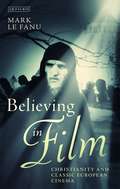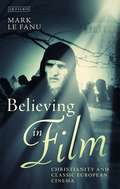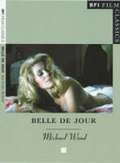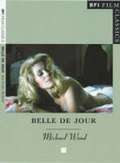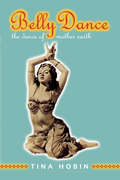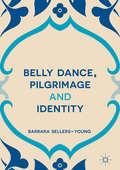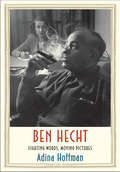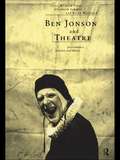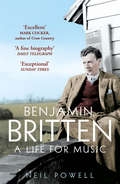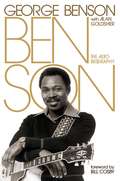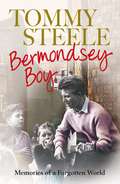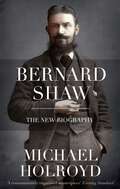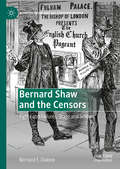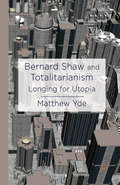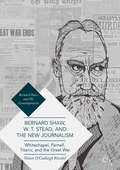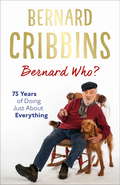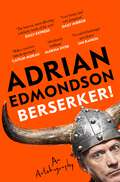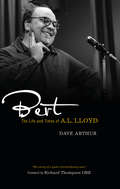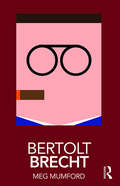- Table View
- List View
Believing in Film: Christianity and Classic European Cinema (Cinema and Society)
by Mark Le FanuWe live in a secular world and cinema is part of that secular edifice. There is no expectation, in modern times, that filmmakers should be believers – any more than we would expect that to be the case of novelists, poets and painters. Yet for all that this is true, many of the greatest directors of classic European cinema (the period from the end of World War II to roughly the middle of the 1980s) were passionately interested not only in the spiritual life but in the complexities of religion itself. In his new book Mark Le Fanu examines religion, and specifically Christianity, not as the repository of theological dogma but rather as an energizing cultural force – an 'inflexion' – that has shaped the narrative of many of the most striking films of the twentieth century. Discussing the work of such cineastes as Eisenstein and Tarkovsky from Russia; Wajda, Zanussi and Kieslowski from Poland; France's Rohmer and Bresson; Pasolini, Fellini and Rossellini from Italy; the Spanish masterpieces of Buñuel, and Bergman and Dreyer from Scandinavia, this book makes a singular contribution to both film and religious studies.
Believing in Film: Christianity and Classic European Cinema (Cinema and Society)
by Mark Le FanuWe live in a secular world and cinema is part of that secular edifice. There is no expectation, in modern times, that filmmakers should be believers – any more than we would expect that to be the case of novelists, poets and painters. Yet for all that this is true, many of the greatest directors of classic European cinema (the period from the end of World War II to roughly the middle of the 1980s) were passionately interested not only in the spiritual life but in the complexities of religion itself. In his new book Mark Le Fanu examines religion, and specifically Christianity, not as the repository of theological dogma but rather as an energizing cultural force – an 'inflexion' – that has shaped the narrative of many of the most striking films of the twentieth century. Discussing the work of such cineastes as Eisenstein and Tarkovsky from Russia; Wajda, Zanussi and Kieslowski from Poland; France's Rohmer and Bresson; Pasolini, Fellini and Rossellini from Italy; the Spanish masterpieces of Buñuel, and Bergman and Dreyer from Scandinavia, this book makes a singular contribution to both film and religious studies.
Belle de Jour (BFI Film Classics)
by Michael WoodSeverine (Catherine Deneuve) is a listless haute bourgeouise wife with a secret afternoon life of prostitution. Her life twists repression and guilt together with uninhibited behaviour, strangled libido with its liberated counterpart. Luis Bunuel was catapulted into cinematic history by his groundbreaking Dali collaboration, Un Chien Andalou, in 1929, but it is Belle de Jour (1967) which inaugurates the extraordinary late phase of his work. It is a film shimmering with reflections on truth, fiction and fantasy, in addition to caustic social insight, as it tells the story of a woman clearing her mind, perhaps, of its ghosts.
Belle de Jour (BFI Film Classics)
by Michael WoodSeverine (Catherine Deneuve) is a listless haute bourgeouise wife with a secret afternoon life of prostitution. Her life twists repression and guilt together with uninhibited behaviour, strangled libido with its liberated counterpart. Luis Bunuel was catapulted into cinematic history by his groundbreaking Dali collaboration, Un Chien Andalou, in 1929, but it is Belle de Jour (1967) which inaugurates the extraordinary late phase of his work. It is a film shimmering with reflections on truth, fiction and fantasy, in addition to caustic social insight, as it tells the story of a woman clearing her mind, perhaps, of its ghosts.
Belly Dance: The Dance of Mother Earth
by Tina HobinTina Hobin - acknowledged expert and practitioner of belly dance, with many years experience of teaching and dancing throughout the world - introduces us to the history of this ancient and mystical dance in an accessible style, both enjoyable and easy to read. Tracing the evolution of belly dance from prehistoric fertility rites, the cult of the shaman and temple dances of Ancient Egypt, she explores how the music and motion of the belly dance featured in the rise and fall of entire empires. Looking also at modern belly dance and its growth across the Western world, Tina Hobin combines the history of dance with an explanation of the health benefits of dance, and a step-by-step guide to modern dance movements. Hobin also asks that we dismiss the commercial exploitation of dance, which is in danger of hiding the art behind this oldest of art forms.
Belly Dance, Pilgrimage and Identity
by Barbara Sellers-YoungThis book examines the globalization of belly dance and the distinct dancing communities that have evolved from it. The history of belly dance has taken place within the global flow of sojourners, immigrants, entrepreneurs, and tourists from the nineteenth to the twenty-first century. In some cases, the dance is transferred to new communities within the gender normative structure of its original location in North Africa and the Middle East. Belly dance also has become part of popular culture’s Orientalist infused discourse. The consequence of this discourse has been a global revision of the solo dances of North Africa and the Middle East into new genres that are still part of the larger belly dance community but are distinct in form and meaning from the dance as practiced within communities in North Africa and the Middle East.
Ben Hecht: Fighting Words, Moving Pictures (Jewish Lives)
by Adina HoffmanA vibrant portrait of one of the most accomplished and prolific American screenwriters, by an award-winning biographer and essayistHe was, according to Pauline Kael, “the greatest American screenwriter.” Jean-Luc Godard called him “a genius” who “invented 80 percent of what is used in Hollywood movies today.” Besides tossing off dozens of now-classic scripts—including Scarface,Twentieth Century, and Notorious—Ben Hecht was known in his day as ace reporter, celebrated playwright, taboo-busting novelist, and the most quick-witted of provocateurs. During World War II, he also emerged as an outspoken crusader for the imperiled Jews of Europe, and later he became a fierce propagandist for pre-1948 Palestine’s Jewish terrorist underground. Whatever the outrage he stirred, this self-declared “child of the century” came to embody much that defined America—especially Jewish America—in his time. Hecht's fame has dimmed with the decades, but Adina Hoffman’s vivid portrait brings this charismatic and contradictory figure back to life on the page. Hecht was a renaissance man of dazzling sorts, and Hoffman—critically acclaimed biographer, former film critic, and eloquent commentator on Middle Eastern culture and politics—is uniquely suited to capture him in all his modes.
Ben Jonson and Theatre: Performance, Practice and Theory
by Richard Cave Elizabeth Schafer Brian WoollandBen Jonson and Theatre is an investigation and celebration of Jonson's plays from the point of view of the theatre practitioner as well as the teacher. Reflecting the increasing interest in the wider field of Renaissance drama, this book bridges the theory/practice divide by debating how Jonson's drama operates in performance. Ben Jonson and Theatre includes: * discussions with and between practitioners * essays on the staging of the plays * edited transcripts of interviews with contemporary practitioners The volume includes contributions from Joan Littlewood, Sam Mendes, John Nettles, Simon Russell Beale and Geoffrey Rush, Oscar-winning actor for Shine.
Ben Jonson and Theatre: Performance, Practice and Theory
by Richard Cave Elizabeth Schafer Brian WoollandBen Jonson and Theatre is an investigation and celebration of Jonson's plays from the point of view of the theatre practitioner as well as the teacher. Reflecting the increasing interest in the wider field of Renaissance drama, this book bridges the theory/practice divide by debating how Jonson's drama operates in performance. Ben Jonson and Theatre includes: * discussions with and between practitioners * essays on the staging of the plays * edited transcripts of interviews with contemporary practitioners The volume includes contributions from Joan Littlewood, Sam Mendes, John Nettles, Simon Russell Beale and Geoffrey Rush, Oscar-winning actor for Shine.
Benjamin Britten: A Life For Music
by Neil PowellBenjamin Britten was the greatest English composer of the twentieth century and one of the outstanding musicians of his age. Born in Lowestoft, Suffolk, in 1913, Britten was the youngest child of a dentist father and amateur musician mother. After studying at the Royal College of Music, he became a vital part of London’s creative and intellectual life during the 1930s, collaborating with W. H. Auden and meeting his lifelong partner, the tenor Peter Pears. At the outbreak of the Second World War, Britten and Pears were already in America, earning a precarious living as freelance musicians before re-crossing the Atlantic by ship in the perilous days of 1942.But the east coast of England was where Britten, as he himself said, belonged: this was where he returned to write his most famous opera, Peter Grimes, and – with Pears and Eric Crozier – to found the Aldeburgh Festival in 1948. In the years that followed, his worldwide reputation grew steadily, helped by a busy schedule of international tours and, for many, crowned by the extraordinary success of his War Requiem. Meanwhile, his festival went from strength to strength, its progress symbolised by the opening of Snape Maltings Concert Hall in 1967.Britten was a mass of paradoxes: a solitary, introspective thinker who came to ebullient life in the company of young people, for whom he composed some of his most memorable works; a man of the political left who was on the friendliest terms with members of the royal family; a composer inspired by some of the twentieth century’s deepest preoccupations who combined innovation with a profound understanding of musical tradition. Devoted to his friends, protégés and fellow musicians, he was, above all, someone who lived for music.Neil Powell’s book is the landmark biography for Britten’s centenary year: a subtle and moving portrait of a brilliant, complex and ultimately loveable man.
Benjamin Britten (Penguin Specials)
by Igor Toronyi-LalicBenjamin Britten was one of the most important and unusual figures in twentieth-century music. This is the perfect introduction to his many wonderful works and his fascinating, controversial life.Benjamin Britten single-handedly transformed the reputation of British classical music. The enormous popular appeal of his great works, such as Peter Grimes (1945) and the Young Person's Guide to the Orchestra (1946), make him the most successful opera composer of any born in the twentieth century. But his success was not without controversy and pain: he was accused of fleeing Britain to avoid military service, he was widely known to be sexually obsessed with boys and he suffered an astonishing array of illnesses. This short book combines a colourful overview of his life with pithy descriptions of all of his major musical works, providing an intimate portrait of this highly unusual man and a persuasive account of his influences, reputation and importance.Each chapter tackles a key episode and theme in his life, from his first compositions at the age of 5, his early friendship and collaboration with W H Auden and the beginnings of his life-long relationship with the tenor Peter Pears, through to his great musical successes and the establishment of the influential, if tempestuous, Aldeburgh Festival, as well as his failures, such as his coronation opera Gloriana (known as 'Boriana') and being satirised by Dudley Moore in Beyond the Fringe - and ending with frank discussions of his naïve politics, his troubling sexuality and his glorious musical legacy.Published to coincide with his 100th anniversary of his birth, this is the perfect introduction to a towering figure of British culture.Igor Toronyi-Lalic is a critic and curator. He writes regularly on music for, among others, The Times and Sunday Telegraph. He is a founder of theartsdesk.com, the author of What's That Thing? (2012), a report on public art, and co-director of the London Contemporary Music Festival.
Benson: The Autobiography (Piano-vocal-guitar Ser.)
by George Benson Alan GoldsherOver the course of his fifty-year career, George Benson has performed for hundreds of millions of fans around the world, received ten Grammy Awards, and recorded with some of the most revered musicians of his era. In 2011, he earned a National Endowment of the Arts Jazz Masters Award. And he has finally decided to tell his story.Benson: The Autobiography follows the musician's remarkable rise from the ghettos of Pittsburgh to the stages of Dubai, and everywhere in between. His tales of scuffling on the road with jazz legend Brother Jack McDuff, navigating his way through the recording studio with Miles Davis, and emerging as the first true (and truly successful) jazz/soul crossover artist will enthrall devotees of both music history and pop culture.An open and truthful raconteur, Benson discusses his near-arrest for domestic abuse, the tragic illnesses that afflicted his family, the secret lives of his musical cohorts, and racism's effect on his life and art. His long-awaited book allows readers to meet one of the most beloved, prolific, and bestselling musicians of any era.
Benson: The Autobiography
by George Benson Alan GoldsherOver the course of his fifty-year career, George Benson has performed for hundreds of millions of fans around the world, received ten Grammy Awards, and recorded with some of the most revered musicians of his era. In 2011, he earned a National Endowment of the Arts Jazz Masters Award. And he has finally decided to tell his story.Benson: The Autobiography follows the musician's remarkable rise from the ghettos of Pittsburgh to the stages of Dubai, and everywhere in between. His tales of scuffling on the road with jazz legend Brother Jack McDuff, navigating his way through the recording studio with Miles Davis, and emerging as the first true (and truly successful) jazz/soul crossover artist will enthrall devotees of both music history and pop culture.An open and truthful raconteur, Benson discusses his near-arrest for domestic abuse, the tragic illnesses that afflicted his family, the secret lives of his musical cohorts, and racism's effect on his life and art. His long-awaited book allows readers to meet one of the most beloved, prolific, and bestselling musicians of any era.
Bermondsey Boy: Memories of a Forgotten World
by Tommy SteeleThirties Bermondsey was a thriving place, and it was in this bustling London borough that Thomas Hicks was born. Later, this Bermondsey boy would become known as Tommy Steele …In this engaging memoir Tommy recalls his childhood years growing up in Bermondsey. He relives with great fondness Saturdays as a young boy, spent gazing at the colourful posters for the Palladium and days spent wandering up Tower Bridge Road to Joyce’s Pie Shop for pie and mash. But he also brings to life with extraordinary vividness what it was like to live through the devastation of the Blitz.Yet it was once he joined the merchant navy and began singing and performing for his fellow seamen that his natural ability as an entertainer marked him out as a favourite. And it was while ashore in America that he became hooked on rock’n’roll and a legend was born …From Tommy’s humble beginning to life at sea and finally as a performer, Bermondsey Boy is a colourful, charming and deeply engaging memoir from a much-loved entertainer.
Bernard Shaw: The New Biography (Great Lives)
by Michael HolroydPlaywright, wit, socialist, polemicist, vegetarian and charmer, Bernard Shaw was a controversial literary figure, the scourge of Victorian values and middle-class pretensions. This is Michael Holroyd's essential biography of George Bernard Shaw. With its pace and verve, its comedy, drama and politics, it portrays a provocative and paradoxical figure sympathetically and movingly.
Bernard Shaw and the Censors: Fights and Failures, Stage and Screen (Bernard Shaw and His Contemporaries)
by Bernard F. Dukore“Dukore’s style is fluid and his wit delightful. I learned a tremendous amount, as will most readers, and Bernard Shaw and the Censors will doubtless be the last word on the topic.”- Michel Pharand, former editor of SHAW: The Journal of Bernard Shaw Studies and author of Bernard Shaw and the French (2001). "This book shows us a new side of Shaw and his complicated relationships to the powerful mechanisms of stage and screen censorship in the long twentieth century.” - - Lauren Arrington, Professor of English, Maynooth University, IrelandA fresh view of Shaw versus stage and screen censors, this book describes Shaw as fighter and failure, whose battles against censorship – of his plays and those of others, of his works for the screen and those of others – he sometimes won but usually lost. We forget usually, because ultimately he prevailed and because his witty reports of defeats are so buoyant, they seem to describe triumphs. We think of him as a celebrity, not an outsider; as a classic, not one of the avant-garde, of which Victorians and Edwardians were intolerant; as ahead of his time, not of it, when he was called “disgusting,” “immoral", and "degenerate.” Yet it took over three decades and a world war before British censors permitted a public performance of Mrs Warren’s Profession. We remember him as an Academy Award winner for Pygmalion, not as an author whose dialogue censors required deletions for showings in the United States. Scrutinizing the powerful stage and cinema censorship in Britain and America, this book focuses on one of its most notable campaigners against them in the last century.
Bernard Shaw and Totalitarianism: Longing for Utopia
by M. YdeThis book reveals the genuity of Shaw's totalitarianism by looking at his material - articles, speeches, letters, etc but is especially concerned with analyzing the utopian desire that runs through so many of Shaw's plays; looking at his political and eugenic utopianism as expressed in his drama and comparing this to his political totalitarianism.
Bernard Shaw, W. T. Stead, and the New Journalism: Whitechapel, Parnell, Titanic, and the Great War
by Nelson O'Ceallaigh RitschelThis book explores Bernard Shaw’s journalism from the mid-1880s through the Great War—a period in which Shaw contributed some of the most powerful and socially relevant journalism the western world has experienced. In approaching Shaw’s journalism, the promoter and abuser of the New Journalism, W. T. Stead, is contrasted to Shaw, as Shaw countered the sensational news copy Stead and his disciples generated. To understand Shaw’s brand of New Journalism, his responses to the popular press’ portrayals of high profile historical crises are examined, while other examples prompting Shaw’s journalism over the period are cited for depth: the 1888 Whitechapel murders, the 1890-91 O’Shea divorce scandal that fell Charles Stewart Parnell, peace crusades within militarism, the catastrophic Titanic sinking, and the Great War. Through Shaw’s journalism that undermined the popular press’ shock efforts that prevented rational thought, Shaw endeavored to promote clear thinking through the immediacy of his critical journalism. Arguably, Shaw saved the free press.
Bernard Shaw, W. T. Stead, and the New Journalism: Whitechapel, Parnell, Titanic, and the Great War
by Nelson O'Ceallaigh RitschelThis book explores Bernard Shaw’s journalism from the mid-1880s through the Great War—a period in which Shaw contributed some of the most powerful and socially relevant journalism the western world has experienced. In approaching Shaw’s journalism, the promoter and abuser of the New Journalism, W. T. Stead, is contrasted to Shaw, as Shaw countered the sensational news copy Stead and his disciples generated. To understand Shaw’s brand of New Journalism, his responses to the popular press’ portrayals of high profile historical crises are examined, while other examples prompting Shaw’s journalism over the period are cited for depth: the 1888 Whitechapel murders, the 1890-91 O’Shea divorce scandal that fell Charles Stewart Parnell, peace crusades within militarism, the catastrophic Titanic sinking, and the Great War. Through Shaw’s journalism that undermined the popular press’ shock efforts that prevented rational thought, Shaw endeavored to promote clear thinking through the immediacy of his critical journalism. Arguably, Shaw saved the free press.
Bernard Who?: 75 Years of Doing Just About Everything
by James Hogg Bernard Cribbins'Essential' DAILY MAIL CELEBRITY BIOGRAPHIES OF THE YEAR'The book reads like it's Bernard sitting down and telling a story' Steve Wright, BBC Radio 2'A fitting celebration of one of our most versatile and enduring acting talents' Sunday Express'A rollicking good read - charming, unassuming and full of amiable, homespun wit' The OldieThe long-awaited autobiography of national treasure Bernard Cribbins.Bernard Cribbins's life has been an eventful one. In 1943, he left school aged fourteen and joined Oldham Repertory Company where he earned fifteen bob for a seventy-hour week. After being called up for National Service in 1946 he became a paratrooper and spent several months in Palestine being shot at. On returning home, and to the theatre, Bernard was eventually approached by George Martin, then an A&R man for Parlophone Records, who suggested he made a record. Just months away from producing The Beatles, Martin asked Bernard to come to Abbey Road Studios in north London and, after teaching him how to sing into a microphone, they eventually recorded two hit singles - 'The Hole in the Ground' and 'Right Said Fred'. These, together with appearances in now classic films such as Two Way Stretch and The Wrong Arm of the Law (not to mention a certain television programme called Jackanory), catapulted Bernard to stardom and, by the time he started filming The Railway Children in 1970, he was already a national treasure.Since then, Bernard's CV has been an A-Z of the best entertainment that Britain has to offer, and, thanks to programmes such as the aforementioned Jackanory, The Wombles, and, more recently, Old Jack's Boat, he has become the voice of many millions of childhoods. Seventy-five years in the making and packed with entertaining anecdotes, Bernard Who? tells the wonderful story of one of the longest and most celebrated careers in show business.
Berserker!: The deeply moving and brilliantly funny memoir from one of Britain's most beloved comedians
by Adrian EdmondsonThe instant Sunday Times bestseller and Financial Times Best Audio of 2023From brutal schooldays to 80s anarchy, through The Young Ones, Bottom and beyond, Berserker! is the one-of-a-kind, fascinating memoir from an icon of British comedy, Adrian Edmondson.Ade Edmondson revolutionized the comedy circuit in the 1980s and, alongside Rik Mayall, brought anarchy to stage and screen. How did a child brought up in a strict Methodist household – and who spent his formative years incarcerated in repressive boarding schools – end up joining the revolution?With wisdom, nostalgia and uniquely observed humour, Ade traces his journey through life and comedy: starting out on the alternative scene, getting arrested in Soho, creating outrageously violent characters and learning more about his curious (possibly Scandinavian) heritage. With star-studded anecdotes and set to a soundtrack of pop hits which transport the reader through time, it’s a memoir like no other.Nominated for Radio Times Moment of the Year for sharing his memories of Rik Mayall on Desert Island Discs.'The Berserker from The Young Ones and Bottom tells his story with self-effacing charm and no end of backstage anecdotes' - Ian Rankin'Amazing' - Richard Osman'Gloriously candid and wise all at once' - Sara Pascoe'It is incredibly funny, but it is also a lot, lot more than that' - Miles Jupp‘More fun than reading Hegel, and also more enlightening’ - Louis de Bernières
Bert: The Life and Times of A. L. Lloyd
by Dave ArthurFolk singer and folk music collector, writer, painter, journalist, art critic, whalerman, sheep station roustabout, Marxist, and much more - this is the story of A. L. (Bert) Lloyd's extraordinary life. *BR**BR*A. L. Lloyd played a key part in the folk music revival of the 1950s and 60s, but that is only part of his story. Dave Arthur documents how Lloyd became a member of the Communist Party, forceful antifascist, trade unionist and an important part of left-wing culture from the early 1930s to his death in 1982. Following his return from Australia as a 21-year-old, self-educated agricultural labourer, he was at the heart of the most important left-wing movements and highly respected for his knowledge in various fields. *BR**BR*Dave Arthur recounts the life of a creative, passionate and life-loving Marxist, and in so doing provides a social history of a turbulent twentieth century.
Bert: The Life and Times of A. L. Lloyd
by Dave ArthurFolk singer and folk music collector, writer, painter, journalist, art critic, whalerman, sheep station roustabout, Marxist, and much more - this is the story of A. L. (Bert) Lloyd's extraordinary life. *BR**BR*A. L. Lloyd played a key part in the folk music revival of the 1950s and 60s, but that is only part of his story. Dave Arthur documents how Lloyd became a member of the Communist Party, forceful antifascist, trade unionist and an important part of left-wing culture from the early 1930s to his death in 1982. Following his return from Australia as a 21-year-old, self-educated agricultural labourer, he was at the heart of the most important left-wing movements and highly respected for his knowledge in various fields. *BR**BR*Dave Arthur recounts the life of a creative, passionate and life-loving Marxist, and in so doing provides a social history of a turbulent twentieth century.
Bertolt Brecht (Routledge Performance Practitioners)
by Meg MumfordBertolt Brecht’s methods of collective experimentation, and his unique framing of the theatrical event as a forum for change, placed him among the most important contributors to the theory and practice of theatre. His work continues to have a significant impact on performance practitioners, critics and teachers alike. Now revised and reissued, this book combines: an overview of the key periods in Brecht’s life and work a clear explanation of his key theories, including the renowned ideas of Gestus and Verfremdung an account of his groundbreaking 1954 production of The Caucasian Chalk Circle an in-depth analysis of his practical exercises and rehearsal methods. As a first step towards critical understanding, and as an initial exploration before going on to further, primary research, Routledge Performance Practitioners are an invaluable resource for students and scholars.
Bertolt Brecht (Routledge Performance Practitioners)
by Meg MumfordBertolt Brecht’s methods of collective experimentation, and his unique framing of the theatrical event as a forum for change, placed him among the most important contributors to the theory and practice of theatre. His work continues to have a significant impact on performance practitioners, critics and teachers alike. Now revised and reissued, this book combines: an overview of the key periods in Brecht’s life and work a clear explanation of his key theories, including the renowned ideas of Gestus and Verfremdung an account of his groundbreaking 1954 production of The Caucasian Chalk Circle an in-depth analysis of his practical exercises and rehearsal methods. As a first step towards critical understanding, and as an initial exploration before going on to further, primary research, Routledge Performance Practitioners are an invaluable resource for students and scholars.
